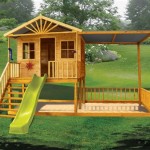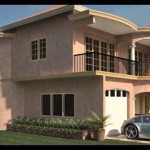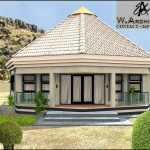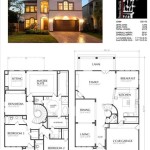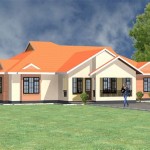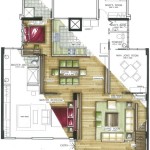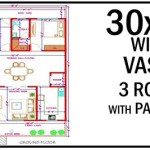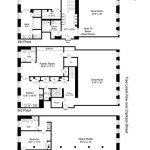1500 Sq Ft House Plans With Basement: Maximizing Space and Functionality
Designing a 1500 sq ft house with a basement presents a unique opportunity to maximize living space and create a functional home that caters to diverse needs. This size allows for comfortable living without being excessively large, making it an ideal choice for small families, couples, or individuals seeking a balance between space and efficiency. Integrating a basement adds significant square footage that can be tailored to a variety of uses, from recreational areas to additional living quarters. Careful planning and design considerations are crucial to ensure the success of such a project.
This article will elaborate on the key considerations involved in designing a 1500 sq ft house plan with a basement, exploring the benefits, challenges, and various design options available. It will also discuss the importance of adhering to building codes and considering the specific needs of the occupants to create a home that is both comfortable and functional.
Key Considerations Before Designing Your House Plan
Before diving into specific house plans, it is essential to address several crucial factors that will significantly impact the overall design and functionality of the home. These considerations include budget, lot size, zoning regulations, and the intended use of the basement space.
Budget: Establishing a realistic budget is the first step in any construction project. It will dictate the quality of materials, the complexity of the design, and the extent to which the basement can be finished. Contingency funds should also be allocated to cover unexpected costs that may arise during construction. Accurate cost estimation requires consulting with builders, architects, and contractors to obtain realistic quotes for materials and labor.
Lot Size and Shape: The size and shape of the lot will influence the footprint of the house and the orientation of the basement. Narrow lots may necessitate a vertical design, while wider lots offer more flexibility in terms of floor plan layouts. Soil conditions and topography should also be assessed to determine the feasibility of constructing a basement. Some soil types may require additional reinforcement or drainage solutions, impacting the overall cost and design.
Zoning Regulations and Building Codes: Zoning regulations dictate what can be built on a specific property, including setbacks, height restrictions, and allowable uses. Building codes ensure the safety and structural integrity of the building. Compliance with these regulations is mandatory and requires obtaining the necessary permits before commencing construction. Local building departments can provide valuable information and guidance on these regulations.
Intended Use of the Basement: Defining the purpose of the basement space is crucial for determining its design. It could be used as a recreational area, a home office, an extra bedroom, a workshop, or simply for storage. The intended use will influence the layout, lighting, ventilation, and finishing requirements. Consider future needs as well, as the basement can be adapted to accommodate changing lifestyles.
Designing the Main Floor (1500 Sq Ft): Layout and Functionality
The main floor of a 1500 sq ft house should be designed to maximize living space and create a comfortable flow between different areas. Open floor plans are a popular choice, as they create a sense of spaciousness and facilitate social interaction. However, defining distinct zones for living, dining, and cooking is important for maintaining functionality.
Living Area: The living area should be a focal point, providing a comfortable space for relaxation and entertainment. Consider the placement of windows to maximize natural light and views. A fireplace or entertainment center can serve as a central element, adding warmth and ambiance. Furniture should be carefully selected to fit the space without overcrowding.
Kitchen and Dining Area: The kitchen should be functional and efficient, with ample counter space and storage. A well-designed kitchen triangle (sink, stove, refrigerator) can minimize wasted steps. Consider incorporating an island or peninsula to provide additional work surfaces and seating. The dining area should be adjacent to the kitchen for easy access and should be sized appropriately to accommodate family meals and gatherings.
Bedrooms and Bathrooms: The number of bedrooms and bathrooms will depend on the needs of the occupants. A master suite with a private bathroom and walk-in closet is a desirable feature. Secondary bedrooms should be adequately sized and located near a shared bathroom. Consider incorporating universal design principles, such as wider doorways and grab bars, to make the home accessible to people of all ages and abilities.
Other Considerations: Entryways should be designed to provide a welcoming and functional space for greeting guests and storing outerwear. Laundry rooms should be conveniently located and equipped with adequate ventilation. Storage spaces, such as closets and pantries, are essential for keeping the home organized and clutter-free. Consider incorporating energy-efficient features, such as high-performance windows and insulation, to reduce utility costs and improve comfort.
Designing the Basement: Maximizing Usable Space
The basement provides an opportunity to significantly increase the living space of a 1500 sq ft house. The design and functionality of the basement depend heavily on its intended use, local building codes, and budget considerations.
Finishing the Basement: Finishing the basement involves adding insulation, drywall, flooring, and other fixtures to create a habitable space. This can significantly increase the value of the home and provide additional living space for various purposes. However, it is important to ensure proper waterproofing and ventilation to prevent moisture problems and maintain air quality.
Basement Layout Options: The layout of the basement can be customized to suit the specific needs of the occupants. Common options include: recreational areas (e.g., home theater, game room), home offices, extra bedrooms, bathrooms, workshops, storage areas, and even self-contained apartments with separate entrances. The layout should be carefully planned to maximize space utilization and create a comfortable and functional environment.
Egress and Safety: Building codes require basements that are used as living spaces to have adequate egress options, such as walk-out doors or egress windows, to ensure safe escape in case of fire or other emergencies. Smoke detectors and carbon monoxide detectors should also be installed to provide early warning of hazardous conditions. Proper lighting and ventilation are essential for creating a comfortable and safe basement environment.
Structural Considerations: The structural integrity of the basement is crucial for the overall stability of the house. Foundation walls should be properly reinforced and waterproofed to prevent water damage and structural problems. Load-bearing walls should be carefully designed and constructed to support the weight of the house above. Consult with a qualified structural engineer to ensure that the basement design meets all applicable building codes and safety standards.
Specific Basement Use Cases:
- Home Theater: If designing a home theater, consider soundproofing the walls and ceiling to minimize noise transmission. Proper lighting and seating arrangements are important for creating an immersive viewing experience.
- Home Office: A home office should be designed to provide a quiet and productive workspace. Adequate lighting, ventilation, and storage are essential. Consider incorporating soundproofing to minimize distractions.
- Extra Bedrooms: Extra bedrooms in the basement require proper egress windows or walk-out doors to meet building code requirements. Adequate ventilation and lighting are also important for creating a comfortable sleeping environment.
- Workshop: A workshop should be equipped with adequate lighting, ventilation, and electrical outlets. Consider incorporating a workbench and storage for tools and materials. Safety should be a top priority.
- Storage Areas: Storage areas should be designed to maximize space utilization. Shelving, cabinets, and bins can help keep items organized and accessible.
Selecting the Right House Plan: Style and Functionality
Choosing the right house plan is a critical step in the design process. Numerous styles and layouts are available, each with its own advantages and disadvantages. Consider the style of the neighborhood, personal preferences, and the specific needs of the occupants when making a selection. A professional architect or designer can provide valuable guidance and help customize a plan to meet specific requirements.
Popular House Styles: Ranch, Craftsman, Traditional, Contemporary, and Modern are popular house styles. Each style has distinct architectural features and aesthetic appeal. Ranch homes are typically single-story and feature open floor plans, making them ideal for aging in place. Craftsman homes are characterized by their handcrafted details and natural materials. Traditional homes often feature symmetrical designs and classic detailing. Contemporary and Modern homes emphasize clean lines, open spaces, and minimalist aesthetics.
Customization Options: Most house plans can be customized to meet specific needs and preferences. This may involve modifying the layout, adding or removing rooms, changing the window configuration, or altering the exterior finishes. Customization allows for creating a truly unique and personalized home. Working with an architect or designer can help navigate the customization process and ensure that the changes are structurally sound and aesthetically pleasing.
Online Resources and Plan Providers: Numerous online resources and plan providers offer a wide selection of house plans. These resources often provide detailed floor plans, elevations, and 3D renderings. However, it is important to carefully evaluate the plans and ensure that they meet local building codes and zoning regulations. Consulting with a local builder or architect can help verify the suitability of a plan for a specific lot and location.
Professional Assistance: Engaging a professional architect or designer can provide invaluable assistance throughout the design process. They can help develop a custom plan that meets specific needs and preferences, ensure compliance with building codes and zoning regulations, and provide guidance on material selection and construction techniques. While professional assistance may involve additional costs, it can ultimately save time, money, and headaches in the long run.
Designing a 1500 sq ft house with a basement requires careful planning, attention to detail, and a thorough understanding of building codes and regulations. By considering the factors discussed in this article, individuals can create a functional, comfortable, and aesthetically pleasing home that maximizes space utilization and meets the specific needs of its occupants.

Pin On Dream Home

House Plan 92395 Ranch Style With 1500 Sq Ft 2 Bed Bath 1

1500 Sq Ft Home Plans Rtm And Onsite In 2024 Basement House Best Ranch

House Plans Under 1500 Square Feet

Our Picks 1 500 Sq Ft Craftsman House Plans Houseplans Blog Com

Our Picks 1 500 Sq Ft Craftsman House Plans Houseplans Blog Com

Our Picks 1 500 Sq Ft Craftsman House Plans Houseplans Blog Com
Our Picks 1 500 Sq Ft Craftsman House Plans Houseplans Blog Com

House Plan 74275 Mediterranean Style With 1500 Sq Ft 3 Bed 2

Not Your Mom S Small Home 1000 1500 Square Foot Designs

